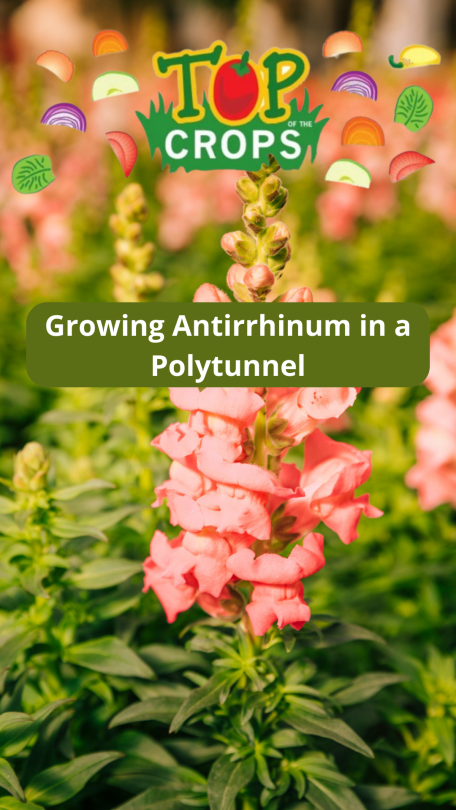Antirrhinums, Snapdragons, are favourites for children to grow, but you do not need to be little to enjoy them. Easy to grow, they can be a good choice for cut flowers, traditional beds or borders, or even as polytunnel plants.
| JAN | FEB | MAR | APR | MAY | JUN | JUL | AUG | SEP | OCT | NOV | DEC | |
| SOW |  |
 |
 |
 |
||||||||
| PLANT |  |
 |
||||||||||
| HARVEST |  |
 |
 |
 |
 |
Antirrhinums are often referred to as snapdragons because the flowers look a little like tiny dragon heads, that open their jaws when the flowers are squeezed on the sides.
Though there are a number of different snapdragons within this genus. When we talk about snapdragons in the UK we are usually talking about Antirrhinum majus, and it is this plant that is the subject of this guide.
Antirrhinum majus is a short-lived herbaceous perennial, which can be woody at the base. However, it is usually grown as an annual plant, and replanted each spring. It grows up to around 1.2m tall, and bears racemes of vibrant flowers up to 5cm across from late spring right through until the autumn.
To grow well, Antirrhinum majus needs:
Full sun.
A sheltered position, ideally south or west facing.
Temperatures between around 4-5 and 21-22 degrees C.
Well-drained or moist but well-drained soil or growing medium.
They can be grown in the ground, in raised beds or in pots.
To grow antirrhinums you will need:
Antirrhinum majus seeds.
Seed tray, seed starting potting mix, propagator etc. for seed sowing.
A suitable growing location for your antirrhinum. (A pot for container gardening).
A trowel for planting out.
Support canes for some taller varieties.
Snapdragons are of course prized for ornamental gardens, and in cut flower gardens for displays inside the home. They are often used in cottage gardens and other rustic and charming garden designs to bring some colour and cheer, and sometimes their delightful fragrance too.
Cheerful and varied, these blooms can give some height to any floral display and give a pretty sense of drama to any indoors arrangements as well as to a bed or border throughout the summer.
Antirrihinum might also be grown as a pollinator attractant in your food producing gardens. Their flower opening is rather heavy, and so the lighter weight honeybees cannot get inside. Snapdragons rely on the heavier bumblebees to pry the flowers open and pollinate them. They can attract these larger bees and other pollinators to your space.
Snapdragons are particularly easy to grow – for kids and adults alike. They can be a good choice even for the least experienced of gardeners, providing blooms over a long period of time, often from June right through to October.
Sow your antirrhinum seeds either in autumn or early spring, indoors in a sunny space or in a polytunnel outdoors. It is often best to use a propagator because the antirrhinum seeds require temperatures of between 16-18 degrees to germinate successfully. However, a sunny windowsill may be sufficient.
You can sow the antirrhinum seeds in late winter/ early spring, in late summer or early autumn, as long as you can provide the necessary conditions for antirrhinum seeds to sprout.
Sow seeds onto the surface of a suitable seed starting potting mix, and do not cover them as light is needed for germination. Water them in well and cover to retain moisture. Prick out and pot on seedlings once they are large enough to handle.
Late summer/ early autumn sown antirrhinum seeds should be overwintered indoors or in a sheltered spot. They will often flower a little earlier – sometimes as early as May. These and spring sown seedlings should be pricked out and potted on, placed in a cold frame or sheltered position, and planted out after all danger of frost has passed where you live.
When planting out snapdragons, you should place to plants at a spacing of around 30cm or so, though precise spacing requirements will depend to a degree on which variety or varieties you have chosen to grow.
After planting, it is a good idea to add a good quality organic mulch around but not touching your snapdragon plants. A layer of homemade compost or leaf mould or well rotted manure should help provide nutrients, conserve soil moisture and suppress weed growth to a degree.
Later, you might also add a mulch of comfrey leaves or other potassium-rich organic matter to promote good flowering over a long period.
Snapdragons can be propagated by seed, but most varieties won't come true, so the plants you grow will not necessarily look like the parent plant. You may still wish to try it to see what comes up.
As long as you need the basic needs of your snapdragons and choose the right growing location, you will generally find that these are not plants that require a lot of care. Water when needed, feed with a potassium-rich organic plant feed, stake taller varieties as needed, and you cannot go too far wrong.
Keep snapdragons well watered through summer when growing undercover or in dry conditions, but take care not to overwater and always avoid waterlogging and make sure excess water can drain away freely.
Try to water the soil and avoid wetting the foliage and flowers to reduce chances of diseases taking hold.
While the flowers are in bloom, promote healthy flowering by using an organic liquid plant feed that is high in potassium when watering your plants.
Once your antirrhinum seedlings have grown 6 leaves and are around 10 cm tall, pinch off the top of the stem to encourage bushiness and branching out.
Deadhead regularly to prolong the flowering period if you have not picked/ harvested your snapdragons for use as cut flowers.
Taller cultivars of snapdragons can grow around 1.2m tall, sometimes even a little taller. So they may need staking to support them, especially when growing outside in somewhat less sheltered conditions. You can also use a grid-type support of stretched twine or mesh netting around the plants if you are growing more of them, to prevent them from falling over.
Snapdragons make good cut flowers. They can look really lovely in vases, and many also smell lovely too. Taller varieties are often particularly prized for home floral displays. The flowers can keep fresh in water for well over a week.
Snapdragons are a relatively easy flower to grow in cool weather, available in a wide array of colours, heights, and varieties.
Antirrhinums are often divided into categories depending on their heights. There are dwarf types that grow just 15-20cm tall, medium varieties, growing 40-75cm in height, and tall varieties, that grow between 75 and 120cm tall.
There are many named cultivars of snapdragons to choose from, including the following which have received an award of garden merit from the RHS:
'Montego Pink' (Montego Series) – dwarf – to 25cm
'Floral Showers Deep Bronze' (Floral Showers Series) – dwarf – to 20cm.
'Liberty Classic Light Pink' (Liberty Classic Series) – medium height – c. 70cm.
All of the above are also considered to be good plants for pollinators.
Though antirrhinum flowers are considered to be particularly easy to grow, as with most plants, there are problems that can arise.
Excessively high temperatures can lead to wilting leaves and fewer flowers. Other environmental condition issues can also cause plants to wilt – such as a lack of water. Make sure you provide the plants with the optimal growing conditions to meet their needs, so the plants don't experience stresses and can lead to wilting or poor flowering.
Yellow and brown flecks on the leaves can sometimes be a sign of snapdragon rust. This problem begins with yellow flecks that slowly grow, developing brown or blackish centres. Prevention is better than cure with this problem – ensure that there is not overcrowding and that there is good air flow around your plants, ventilate the space well when growing undercover.
Leggy plants can get top heavy and may fall over or be blown over. Make sure that you provide support for taller specimens where necessary so that you do not encounter this problem.
Pests are not usually a problem when growing Antirrhinums. Look out, however, for sap-sucking insects like aphids. Keep their numbers down by boosting biodiversity in your garden and drawing in natural predators such as ladybirds and lacewings, for example.
As mentioned above, one fungal issue that can impact snapdragons is rust. It is important to remain vigilant and to remove any affected plant material as quickly as possible to prevent its spread.
Since rust can overwinter in warm conditions, it is a good idea to treat snapdragons as annual plants, and to remove all spring sown plants at the end of the growing season to prevent the build-up of disease.
It is best to rotate snapdragons between different garden beds too, as you would certain crops in your vegetable garden, as crop rotation also helps reduce the chances of build-up of diseases in the soil.
Other fungal issues can also arise. For example, snapdragon seedlings can sometimes wilt and die early due to damping off. Good gardening hygiene is important, as is making sure you use a suitable seed-starting growing medium.
Downy mildew is another issue that can affect young snapdragon plants. Again, affected material should be removed as soon as possible to prevent the spread of this problem. Not watering from above and wetting the foliage and good plant spacing will reduce the chances of this issue taking hold.
Powdery mildew is another issue that may sometimes arise when growing Antirrhinum plants. This can be seen as a powdery, white coating on the leaves. Watering well but making sure leaves are not wet will reduce the chances of this problem taking hold.
Other problems that can sometimes occur when growing snapdragons include fusarium wilt, sclerotina diseases, leaf spots, shot hole, verticillium wilt... keeping plants as healthy and happy as possible by providing the right growing conditions and care will considerably reduce the chances of any serious problems taking hold.
Snapdragons can often fare well in a polytunnel rather than outdoors, as the polytunnel provides the sheltered conditions these plants desire.
However, it is important to keep the tunnel relatively cool through summer with good ventilation as these flowers won't like it if temperatures climb much above around 21 degrees C.
Consider using Antirrhinum majus as a companion plant that will help to draw in pollinators to your polytunnel garden. As long as doors and vents are open to allow pollinators inside, using snapdragons and other flowers in a vegetable garden can help you to successfully grow insect-pollinated edible crops.
Caramela, S., (2023) Snapdragon: Meaning, Symbolism, and Proper Occasions. A-Z Animals. [online] Available at: https://a-z-animals.com/blog/snapdragon-meaning-symbolism-and-proper-occasions/
